Clinical Significance of Serum Biomarkers in Stage IV Non-Small-Cell Lung Cancer Treated with PD-1 Inhibitors: LIPI Score, NLR, dNLR, LMR, and PAB
- PMID: 35945957
- PMCID: PMC9357262
- DOI: 10.1155/2022/7137357
Clinical Significance of Serum Biomarkers in Stage IV Non-Small-Cell Lung Cancer Treated with PD-1 Inhibitors: LIPI Score, NLR, dNLR, LMR, and PAB
Abstract
Background: To assess the prognostic value of pretreatment serum biomarkers in stage IV non-small-cell lung cancer (NSCLC) patients treated with PD-1 (programmed cell death protein 1) inhibitors and their value as a predictor of benefit.
Methods: We performed a retrospective study including patients with stage IV NSCLC who were treated with anti-PD-1 drugs in first or advanced lines of therapy in the Affiliated Tumor Hospital of Nantong University. Serum biomarkers such as NLR, dNLR, LMR, PAB, ALB, and LIPI scores were calculated and analyzed in detail.
Results: A total of 85 patients with stage IV NSCLC treated with PD-1 inhibitors in the first or advanced lines of therapy were included in this subject. According to the tumor response of PD-1-based treatment, ORR was 42.4% (36/85) and DCR was 68.2% (58/85). The median OS and PFS were 20.0 months and 7.0 months, respectively. The ROC curves showed that the serum biomarkers of NLR, dNLR, LDH, LMR, PAB, and ALB were significantly associated with overall survival and helped to determine the cut-off value. The multivariate Cox proportional hazard analyses for stage IV NSCLC patients treated with PD-1 inhibitors indicated that dNLR (P < 0.001) and ALB (P = 0.033) were independent prognostic indicators of PFS, while liver metastasis (P = 0.01), NLR (P = 0.01), dNLR (P = 0.001), and LMR (P = 0.006) were independent prognostic indicators of OS. Moreover, patients of the good LIPI group showed prolonged PFS and OS than those with intermediate/poor LIPI score (P < 0.001 and P = 0.006, respectively).
Conclusions: Pretreatment dNLR is an independent prognostic indicator of both PFS and OS in stage IV NSCLC patients treated with PD-1 inhibitors. Pretreatment LIPI, combining dNLR > 3 and LDH>ULN, was correlated with worse outcome for stage IV NSCLC patients treated with ICI. High NLR, high dNLR, low LMR, and low ALB at baseline might be useful as an early predictive biomarker of benefit.
Copyright © 2022 Jia Chen et al.
Conflict of interest statement
The authors have declared that no competing interest exists.
Figures
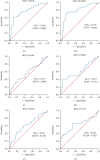

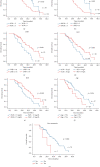
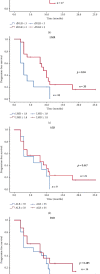
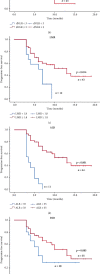
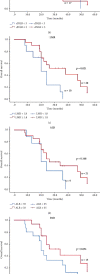
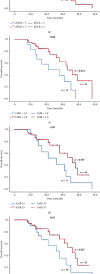

Similar articles
-
Association of the Lung Immune Prognostic Index With Immune Checkpoint Inhibitor Outcomes in Patients With Advanced Non-Small Cell Lung Cancer.JAMA Oncol. 2018 Mar 1;4(3):351-357. doi: 10.1001/jamaoncol.2017.4771. JAMA Oncol. 2018. PMID: 29327044 Free PMC article.
-
Association Between Lung Immune Prognostic Index and Durvalumab Consolidation Outcomes in Patients With Locally Advanced Non-Small-Cell Lung Cancer.Clin Lung Cancer. 2024 May;25(3):233-243.e8. doi: 10.1016/j.cllc.2023.11.007. Epub 2023 Nov 22. Clin Lung Cancer. 2024. PMID: 38105153
-
Prognostic value of inflammatory markers NLR, PLR, LMR, dNLR, ANC in melanoma patients treated with immune checkpoint inhibitors: a meta-analysis and systematic review.Front Immunol. 2024 Oct 18;15:1482746. doi: 10.3389/fimmu.2024.1482746. eCollection 2024. Front Immunol. 2024. PMID: 39493767 Free PMC article.
-
[Effect of dNLR and LIPI scores on the prognosis of elderly patients with non-surgical treatment of non-small cell lung cancer].Zhonghua Zhong Liu Za Zhi. 2022 Sep 23;44(9):975-980. doi: 10.3760/cma.j.cn112152-20200423-00371. Zhonghua Zhong Liu Za Zhi. 2022. PMID: 36164700 Chinese.
-
Systemic Inflammatory Markers of Survival in Epidermal Growth Factor-Mutated Non-Small-Cell Lung Cancer: Single-Institution Analysis, Systematic Review, and Meta-analysis.Clin Lung Cancer. 2021 Sep;22(5):390-407. doi: 10.1016/j.cllc.2021.01.002. Epub 2021 Jan 10. Clin Lung Cancer. 2021. PMID: 33582072
Cited by
-
Association between the modified lung immune predictive index and clinical outcomes of advanced non-small cell lung cancer treated with first-line immune checkpoint inhibitors combined with chemotherapy.J Thorac Dis. 2023 Nov 30;15(11):6279-6290. doi: 10.21037/jtd-23-1525. Epub 2023 Nov 23. J Thorac Dis. 2023. PMID: 38090322 Free PMC article.
-
Clinical characteristics and novel strategies of immune checkpoint inhibitor rechallenge therapy for non-small cell lung cancer: a comprehensive review.Front Immunol. 2024 Jan 12;14:1309055. doi: 10.3389/fimmu.2023.1309055. eCollection 2023. Front Immunol. 2024. PMID: 38283354 Free PMC article. Review.
-
Prognostic Value of Lymphocyte-to-Monocyte Ratio (LMR) in Cancer Patients Undergoing Immune Checkpoint Inhibitors.Dis Markers. 2022 Dec 23;2022:3610038. doi: 10.1155/2022/3610038. eCollection 2022. Dis Markers. 2022. PMID: 36590752 Free PMC article.
-
Blood-based biomarkers in soft tissue sarcoma: Implications for immune checkpoint inhibitor therapy.Int J Cancer. 2025 Sep 15;157(6):1031-1042. doi: 10.1002/ijc.35477. Epub 2025 May 14. Int J Cancer. 2025. PMID: 40366309 Free PMC article. Review.
-
Plasmacytoid Dendritic Cell, Slan+-Monocyte and Natural Killer Cell Counts Function as Blood Cell-Based Biomarkers for Predicting Responses to Immune Checkpoint Inhibitor Monotherapy in Non-Small Cell Lung Cancer Patients.Cancers (Basel). 2023 Nov 3;15(21):5285. doi: 10.3390/cancers15215285. Cancers (Basel). 2023. PMID: 37958458 Free PMC article.
References
MeSH terms
Substances
LinkOut - more resources
Full Text Sources
Medical
Research Materials
Miscellaneous

